McFarland High School’s new Performing Arts Center is anything but a typical high-school auditorium; this expertly designed theater space is intended to serve as a cultural hub for the greater McFarland WI community in addition to serving the needs of the school’s performing-arts program well into the future.
Officially known as the McFarland Performing Arts Center, the building was a new construction funded by a community referendum passed in 2016 that authorized $65 million in construction projects throughout the district (a portion of this funding was earmarked for the new theater). The school district’s leadership saw the construction of a new theater not only as an opportunity to address the deficiencies of the school’s old theater (constructed in 1978), but also as a way to provide the village of McFarland with a state-of-the-art performing-arts venue for musical and theater groups at both the professional and hobbyist level.
In a sense, the theater was built to be a new home for the performing arts in this small suburb of Madison WI. The school district’s leadership took this task seriously from the earliest stages of the project. That tone was set from the top down by Dr. Andrew Briddell, Superintendent for the School District of McFarland, who—perhaps unusually for a school administrator—has great insight into the performing arts thanks to his background in music education as a band and orchestra director, as well as his performing experience as a professional symphony musician. Briddell and the district contracted theater designer Bill Connor & Associates, acoustic consultant Stan Roller & Associates, architectural firm Plunkett Raysich Architects and builder J.H. Findorff & Son to handle the construction of the new space. The theater’s AV systems were designed by Stan Roller & Associates’ David Walters and they were installed by Platteville WI-based Lifeline Audio Video Technologies, which was hired as a subcontractor under the electrical contractor, Electrical Solutions. The Lifeline AV team was led by Operations Manager Dean Goninen, and included Lead Technician/Programmer Adam King and Technicians Chris Schmidt, Zachary Schrab and Jared Pink. The lighting systems were provided by MainStage Theatrical Supply.
According to Goninen, Briddell’s background in theater made him the ideal person to pull this team of contractors together. “The success of the project really does go back to the organization of the team. Andrew is like a master of organizing,” he said. “He brought a different passion that we don’t normally see, from an administrator standpoint. Because of his background, he understood the language and could either make a decision right away or help you get an answer. It was enjoyable just to have someone that had that passion, that interest, involved. It made the project go that much smoother. He knew how to carry the ball.”
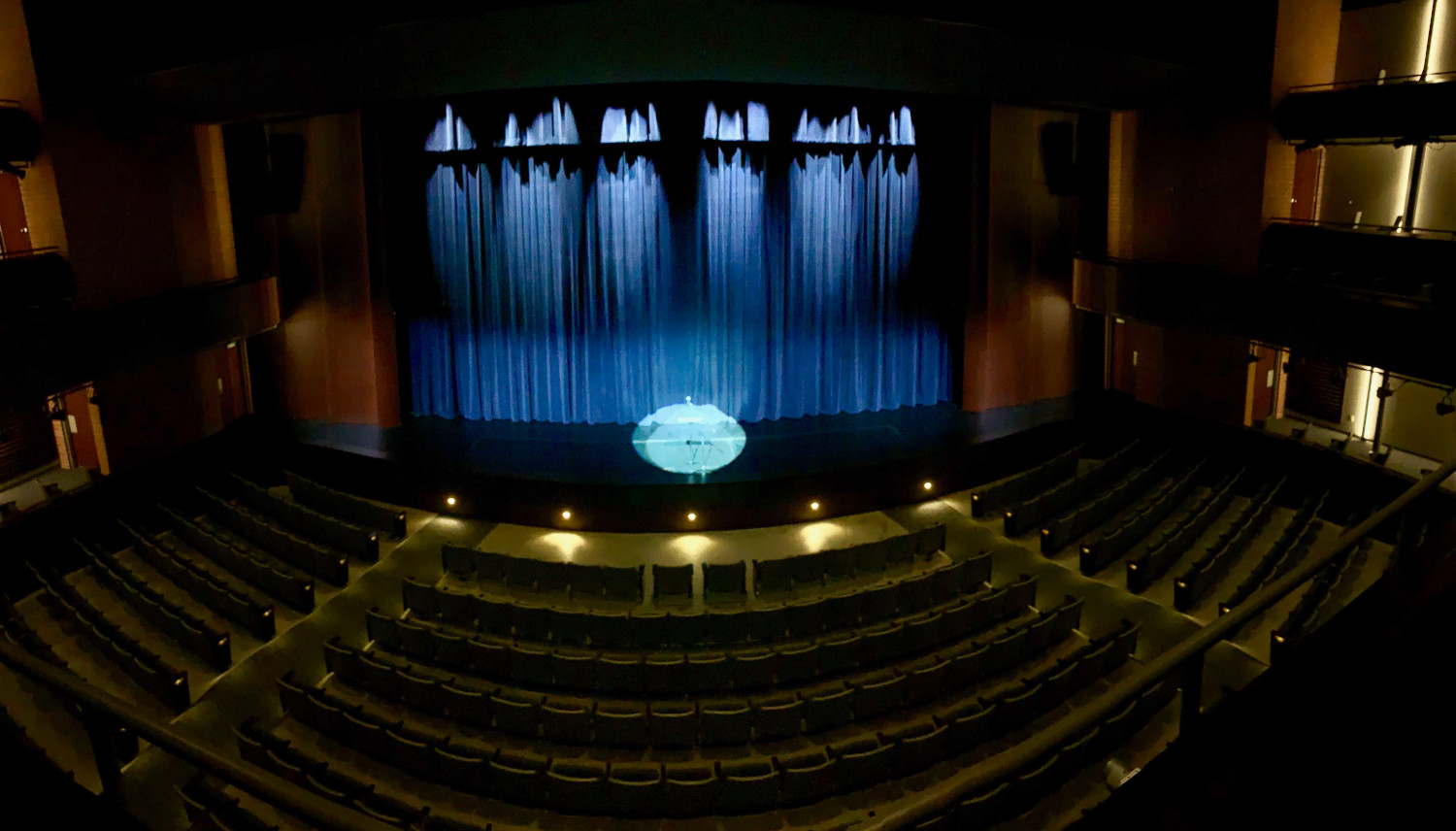
Better AVL, More Flexibility
McFarland High School’s old theater had been outpaced by the growth of the school’s student body and its performing-arts programs, so the main priorities for the new theater were more seating, a bigger stage, and much more sophisticated audio, video and lighting systems to complement the room’s sophisticated acoustical design. The school also wanted to make sure the new theater was equipped with features that would allow more flexibility in hosting performances, such as a dedicated orchestra pit and a backstage scene shop.
“We’ve had a really strong tradition of performing arts in McFarland for many, many years, going back to when the high school first opened in 1962. The old space was originally built in 1978, and it held 481 people. At the time, there were 350 students at the high school,” Briddell explained. “Fast forward to 2016, when we passed the referendum, there are now 750 students in McFarland High School. We wanted to be able to have the entire student body and staff in our performing arts center, so that put us at a target seating capacity of 850.” He added, “We had outgrown [the old theater] in terms of the size of the bands, the choirs and the productions that we were doing in the space. We really wanted to increase the capacity and what we could handle in terms of productions. We wanted to improve the experience for the audience members. And we also wanted to make it a place that would be a desirable venue for outside groups to come and perform and enhance the community here in McFarland. [The new theater has] been a natural growth of all of those interests coming together.”
The McFarland Performing Arts Center seats 841. The main floor’s raked seating gradually rises to the back wall, with the rear three rows of floor seating occupying a parterre underneath a six-row balcony above. In addition, there are four levels of small side seating galleries to the left and right: one at floor height, one at the top balcony row height, one at the bottom balcony row height, and one on a mezzanine level in between the main floor and the balcony.
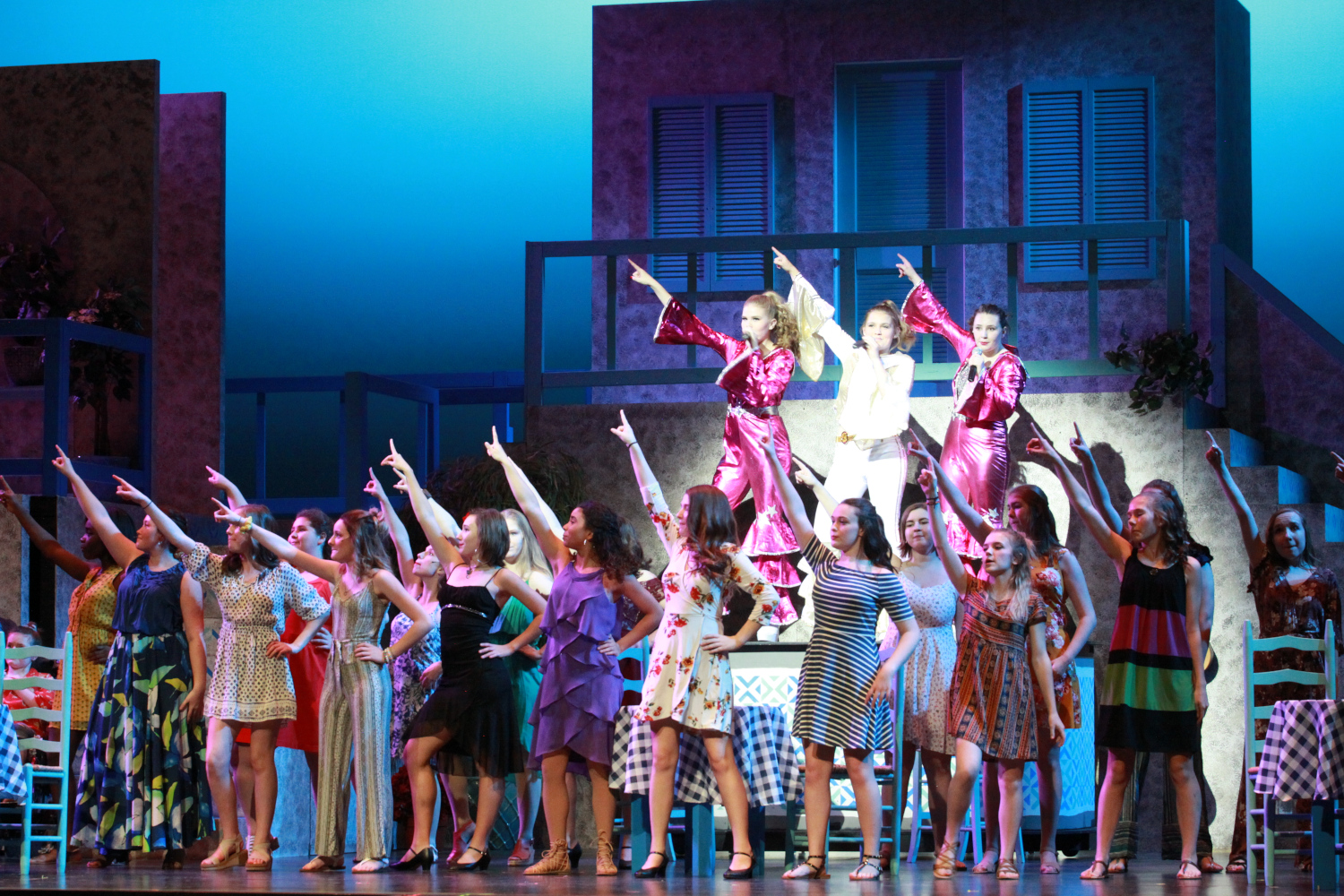
Acoustic & Audio System Design
Designing a theater that would meet the growing requirements of McFarland High School’s performing-arts programs, while also supporting the music and theater programs of a number of local middle schools, as well as outside groups, such as the Wisconsin Youth Symphony Orchestras, was a task that was firmly within the wheelhouse of Stan Roller & Associates’ expert team.
David Walters explained the Stan Roller team’s approach to the project: “The acoustic space was designed by Stan Roller, who is a Principal Consultant, as well the Owner of the company, and he was assisted by [CEO and Principal Consultant] Mike Drapak. I modeled the systems and the coverage.” Walters added that Roller’s wealth of experience was the driving force behind the acoustic design of the space. According to Walters, “Stan’s been doing this for about 50 years, and he’s done probably over 300 theaters in that time. He started out with Bolt Beranek Newman, and there are very few [guys like him] left.”
Walters described the client’s expectations for the theater and how the acoustic design of the room and its AV systems complement each other to provide flexibility for many types of performances. “They certainly wanted good carry for their orchestra and for classical-type music, like your standard symphonies and orchestras. And we also had to get that to work well when they do something more high energy, like a musical. It’s a little bit of a challenge, acoustically, to do that, because one [approach] cries out for a little more of a responsive space.” He added, “I always control my talk of reverberation time, because there’s a lot more to space than just a reverberation time; it varies with frequency. So, we look for a response curve. And in the room, as it is now, you can hear somebody with a decent set of lungs on them singing or talking at a loud level without any reinforcement. It’s when you start throwing bands and all the other stuff on top of the voices and you want to get a higher level, then we need to start amplifying.”

Sound Reinforcement
The sound-reinforcement system centers on two Renkus-Heinz Varia line arrays, which are installed in a left/right configuration along the stage’s proscenium arch. Each array is composed of three VAX101i-7/9 modules, one VA/VAX101i-15/9 module and one VAX15Si subwoofer.
“We had a tight budget, so everything had to be best bang for the buck. The Renkus-Heinz arrays gave us [the sound pressure levels] we needed and good sonic quality at the best price,” Walters said. “Plus, I love that you can get different horizontal and vertical dispersions for the boxes and custom build your coverage. I also like the voicing on RenkusHeinz speakers. They’ve got the output. They certainly have the horsepower to do something higher-energy, and we could do it with less array elements than I would have had to use [otherwise].”
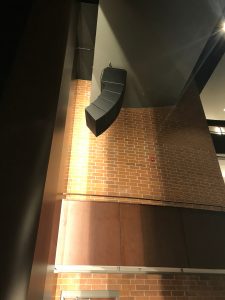
The line arrays are complemented by a center cluster composed of RenkusHeinz STX Series speakers, including three STX6M modules and one STX4L subwoofer.
“The center cluster was designed for dialogue and spoken word, like during dramas,” Walter described. “I find speech much more intelligible coming from a single point rather than a left/right array. I’ve never really been happy with pure spoken word coming out of a left/right array because when you sit, you’re either closer to the right or you’re closer to the left, so you get some comb filtering that occurs due to the different arrival times. So, the center cluster is for speech and dialogue, and then when they do something more musically high-energy, that goes through the left/right arrays.”
The first few rows of main-floor seating are covered by 11 JBL Control 25AV speakers, which are installed along the front edge of the stage. “The center cluster sits above the front eyebrow [of the proscenium arch], so it’s slightly ahead of the stage. I have the front fills there to help fill that in. I also like to shift the sound field down to the stage,” Walters explained. He added that he generally prefers using front-fill speakers to using down-fills in the mounted arrays, or elsewhere, because front-fills help keep the audience’s focus at stage level. “I’ve never had it work very well to do down-fills on the stage. Besides there being the possibility of putting too much sound at the front of the stage and causing some feedback issues, it also sounds abnormal. As you move forward, you begin to notice that the sound is indeed coming from above, and it always seemed a little disembodied to me. So, I like the front fills.”
The three-row parterre at the rear of the main floor is covered by six JBL Control 26-DT under-balcony fill speakers. In the balcony seating above, coverage for the back rows is supplemented by four Renkus-Heinz TRX81/9 fills. The side seating areas are also covered by TRX81/9 fills; there are two for each side. “The side seats have fill speakers mostly just for the mid and high frequencies, for intelligibility. We’re running them from about 300Hz to about 4kHz, just to fill [those frequencies] in,” Walters said.
The sound-reinforcement system is controlled via a Midas M32IP 40-channel digital console at front of house. The digital console can also be controlled via iPad. A Biamp AudiaFLEX digital audio platform handles equalization and crossover for all the speaker systems, which are powered by QSC CX Series two-channel amplifiers. The front-of-house desk also features a TASCAM CD player/iPod dock for playing recorded music over the sound system, as well as a TASCAM solid-state recorder. The venue also features a Listen Technologies LT 800 Series RF-based assistive-listening system, which is tied to the mixing console. A Telex two-channel wireless-intercom system with headset receivers allows for discreet communication during productions.
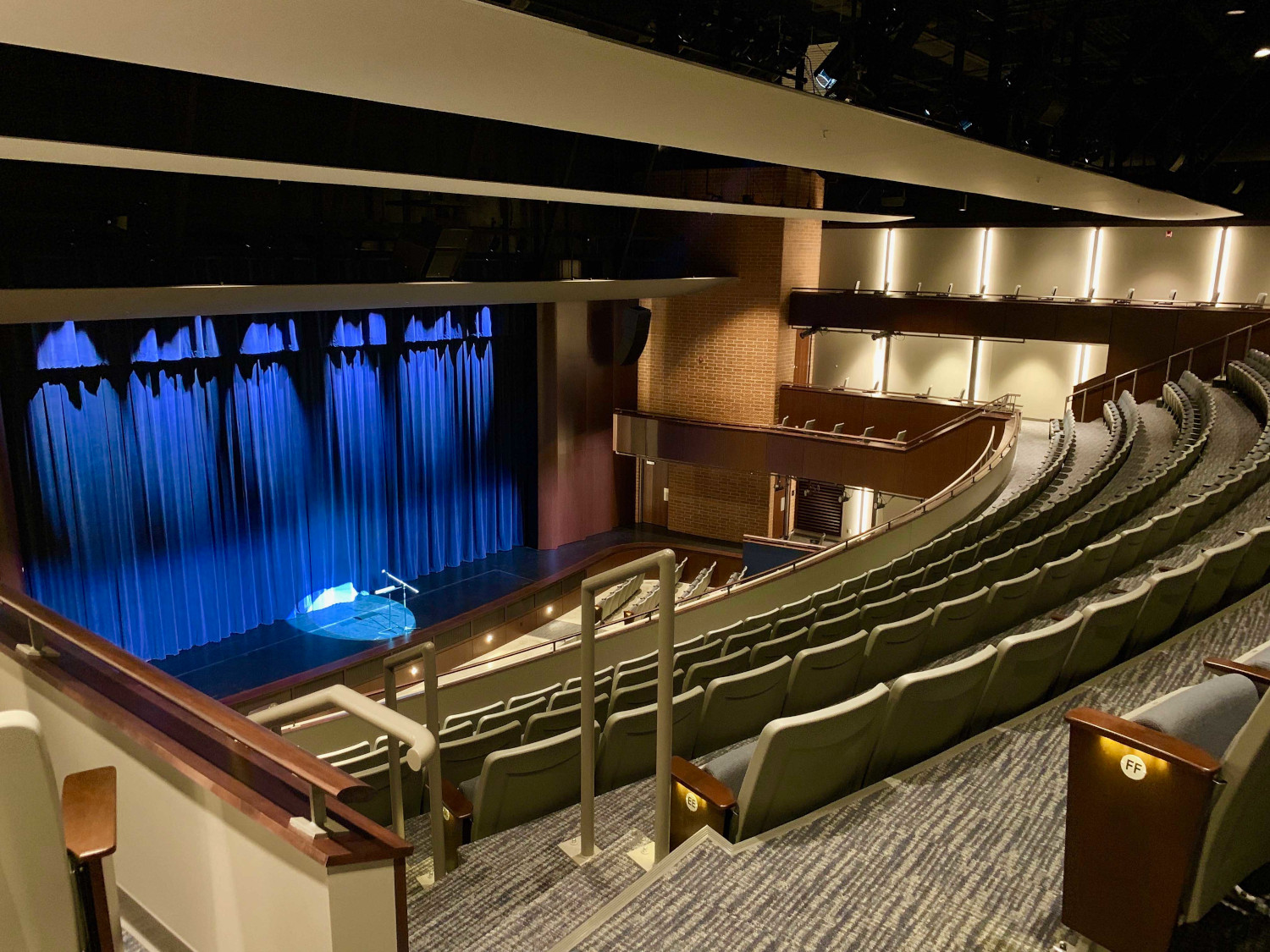
Audio & Video Inputs
Microphones include a Shure QLXD wireless system with 18 wireless bodypacks that are used with Shure WCE6T headsets and BETA 58A handheld mics, plus Shure BETA 58A and BETA 87A wired mics. The auditorium is also equipped with two Shure MX202BP/C hanging condenser mics. For monitors, four QSC E110 passive speakers can be placed flexibly around the space. Stage boxes with mic inputs and monitor sends are located stage left and stage right, as well as in the orchestra pit.
“There are 16 mic inputs on the wing walls, left and right, with monitor sends. And there are two panels in the orchestra pit with eight mics on each panel,” Walters described. “We’ve got conduits with Cat cables running out to the panels. So, they have two redundant network sends to the stage left and stage right wing walls and the orchestra pit. Those go back to a patch panel at the main equipment rack. And there are also two redundant networks that go from front of house to the equipment racks. So, if somebody comes in, if they have a digital snake or something, they can utilize those and expand. You could put a sidecar mixer in there, or if, in the future, the school decides to put in a larger mixer, they have the networks there to do it. That gives you the flexibility to put your own switch in and create a network to do whatever you want to do.”
The theater is also equipped with a video-projection system. A Christie Digital DHD951-Q 1DLP projector fires on a Draper Paragon E 300-inch projection screen, which is hung from the center of the proscenium arch. The video system’s backbone is built on Extron components, including a DA 12V/6V Dual EQ distribution amplifier, an IN1608 scaling presentation switcher, an EBDB MINI mini eBUS distribution hub, and wallplates for controlling the projection screen and video inputs. The projector is mainly used for presentations and school meetings, and the system was designed for simplicity, since it is mainly used by teachers and faculty.
Other video components in the system include a number of Samsung displays, which are used as video monitors in the backstage area, the dressing rooms, the orchestra pit and the scene shop. These video monitors receive a view of the stage that is captured by a Panasonic WV-CP304 fixed camera mounted on the balcony.
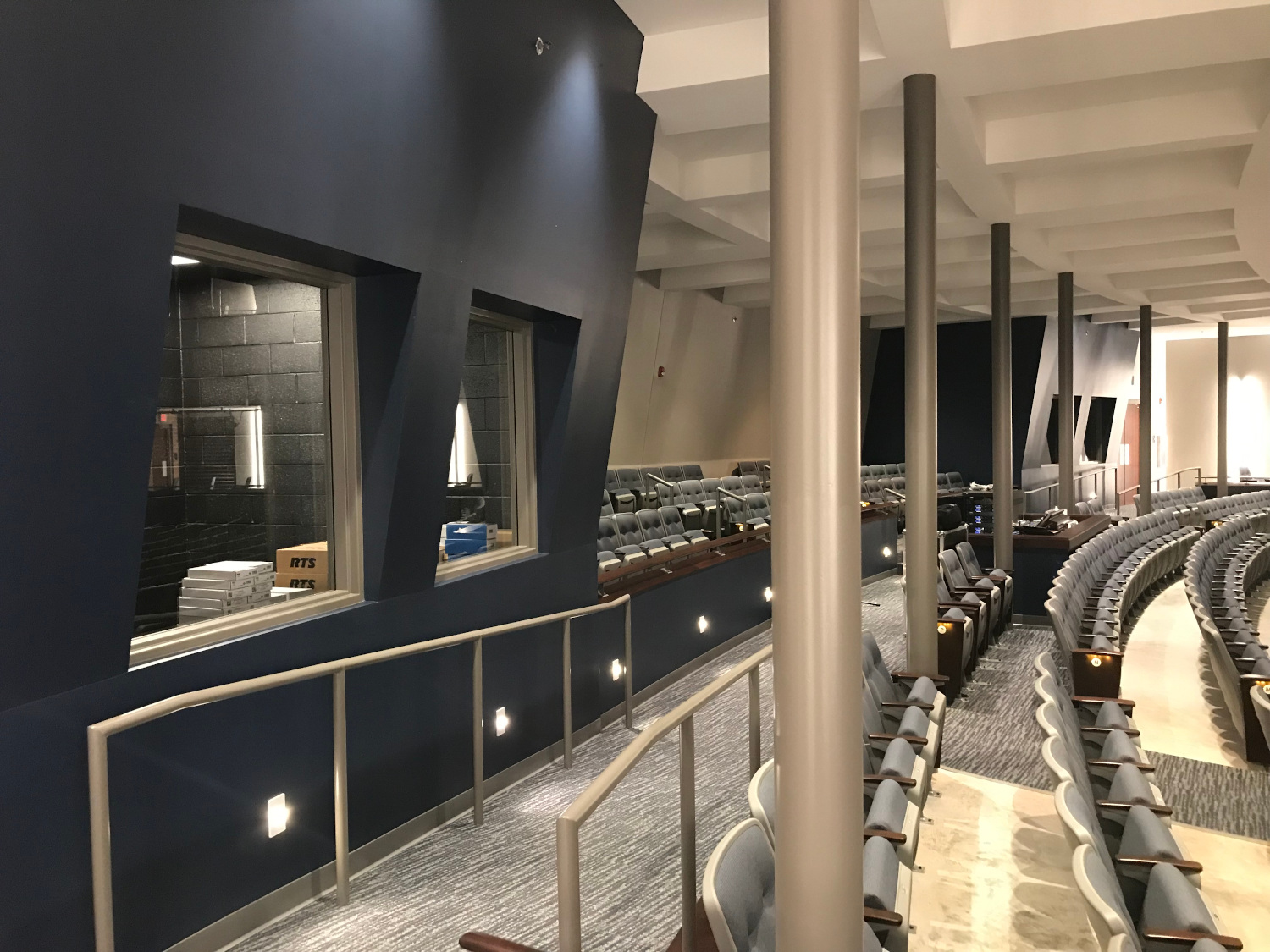
Skills Development
On the lighting front, McFarland wanted to ensure that the performing arts center had a flexible, professional-level lighting system to complement the onstage performances. But the lighting system, much like the audio system, was also built with an eye toward offering the students involved in theater arts programs skills development training in the future.
“We wanted to have a lighting system that was LED-based, fully programmable and also very flexible in terms of positioning fixtures. We wanted a system that was sophisticated enough to support outside groups that might come in and sophisticated performances that we might do internally. And we also wanted to be able to teach students how to operate it with proper training and guidance,” Briddell shared.
The intention is eventually to create a formal program to train students for jobs in theater-related trades, with the theater itself functioning as a teaching space. “One of the things [we envisioned for] the long term with this new space, since we’ve always had a group of students [who] have been involved in the theater tech side of performing arts—stagecraft, set building, sound and lights—we want to be able to not only continue to do that, but [also] enhance what we offer. We have a magnificent Career and Technical Education department that is a great prep program for the trades and for Madison Area Technical College. And we would like to see our performing arts center being able to serve the same capacity for kids who want to study theater tech. Now we have a facility that certainly would support that.”
In addition to being a major upgrade for the school and an enticing venue for outside performers, the McFarland Performing Arts Center also offers a much improved experience for the audience.
In fact, Goninen was able to share his perspective not only as an integrator, but also as an audience member. He attended a performance of McFarland High School’s production of “Mama Mia!” last November—before the school closed its facilities due to the novel coronavirus (COVID-19) pandemic—and was impressed not only by the AV systems, but also by the caliber of the performance. “I think I caught the second night,” he said. “The use of the space…I was amazed. I went there to watch our AV system work, but I thoroughly enjoyed the show. They did a great job. It was fantastic. And it was great night of entertainment.” He added, “It’s a beautiful space. And the advanced technology that it has…not many schools get to [deliver that] experience.”
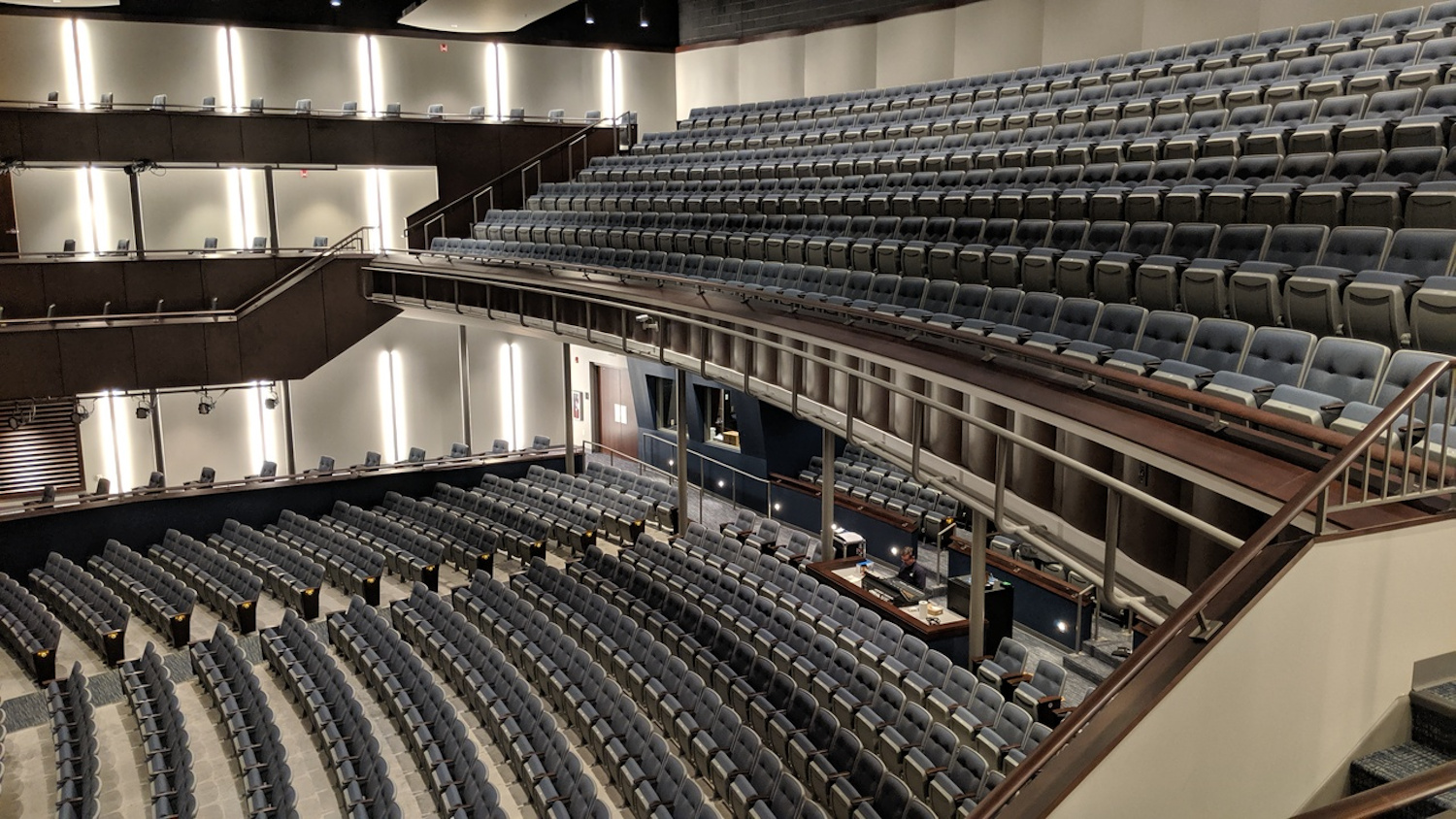
Walters echoed the enthusiasm for the space, emphasizing that the school got the most out of its relatively small budget. “The budget was very tight on the project, as you can imagine—it’s a high school,” he said. “I think it came out just beautifully for the amount of money they spent. It wasn’t a cheap project, but it wasn’t as expensive as some can be. But they got really good value. The distribution of sound is really even—both from the system and from natural acoustics. And I think it’s a beautiful-looking room.”
Taken altogether, the venue seems to have met all the school district’s expectations. “We are beyond thrilled,” Briddell said. “Every time I would bring somebody in there on a tour before it even opened up, and when the kids and the parents got to see it the first time, the reaction was the same across the board. You’d walk into the room and everybody would just sort of stand still, just in shock at how magnificent the space is. We are just absolutely delighted and so grateful to have this space. And we’re really excited about the opportunities it affords our students and the whole community for many, many, many years.”
Briddell added that the various contractors involved in the project all more than met expectations. “We’ve got really, really fine acoustic properties in the new theater, and the sound system enhances that,” he said. “I just want to say thank you to everybody involved. We couldn’t be happier. Personally, it’s been so exciting and gratifying to be a part of this project. And I’m very grateful on behalf of the McFarland community to everybody involved in putting this together.”

EQUIPMENT
AMPS
1 QSC 2-channel, 70V power amp (2 channels, 550W/ch at 8Ω, 440W/ch at 70V)
2 QSC CX1102 2-channel, 1,100W power amps
7 QSC power amps (2 channels, 300W/ch at 8Ω, 500W/ch at 4Ω, 800W/ch at 2Ω)
ASSISTIVE-LISTENING SYSTEM
1 Listen Technologies LA-122 universal antenna kit (72MHz and 216MHz)
6 Listen Technologies LA-161 single ear buds
1 Listen Technologies LA-326 universal rackmounting kit
6 Listen Technologies LA-361 high-capacity AA alkaline batteries
6 Listen Technologies LR-400-072 portable display RF receivers (72MHz)
1 Listen Technologies LT-800-072-01 stationary RF transmitter (72MHz)
AUDITORIUM STAGE VIDEO-MONITORING SYSTEMS
1 Extron DA 6V EQ 6-output composite-video distribution amp w/gain and EQ controls
1 Panasonic WV-CP304 day/night fixed camera
1 Panasonic WV-LZ62/8S 1/3″ 5-40mm special-C-mount vari-focal lens w/auto iris, silver body
1 Pelco CM1450 die-cast aluminum wallmount
EQUIPMENT RACKS & ACCESSORIES
1 Middle Atlantic DWR-18-22 DWR Series rack
2 Middle Atlantic DWRSRZL zero-clearance latches for DWR/SR Series racks
11 Middle Atlantic EB1 blank panels (1RU, steel, flanged)
2 Middle Atlantic EB2 blank panels (2RU, steel, flanged)
2 Middle Atlantic EB3 blank panels (3RU, steel, flanged)
1 Middle Atlantic EB4 blank panel (4RU, steel, flanged)
1 Middle Atlantic EB5 blank panel (5RU, steel, flanged)
2 Middle Atlantic EB6 blank panels (6RU, steel, flanged)
1 Middle Atlantic FD-18 solid front door (18RU rack)
1 Middle Atlantic ISRK-12GY ISRK Series rack
1 Middle Atlantic PD-920R-NS rackmount power (9-outlet, 20A)
3 Middle Atlantic PDT-615C-NS power strips (6-outlet, 15A)
1 Middle Atlantic PTRK-2126 PTRK Series rack
2 Middle Atlantic SR-40-32 SR Series racks
2 Middle Atlantic TD3 drawers (3RU, textured)
1 Middle Atlantic TD4 drawer (4RU, textured)
GAIN & EQ CONTROLS
1 Bosch UML-100-90 general-purpose LCD monitor
1 Bosch UMM-LCDUB-RM rackmount bracket
4 Chief FWP110B small pitch/pivot wall display mounts
4 Samsung UN19F4000AFXZA 19″-class F4000 LED TVs
INTERCOMS
6 Telex BP-2002 dual-channel wired intercom beltpack transceivers w/sidetone controls, talk/call buttons and indicators
6 Telex HR-1 single-sided headsets w/boom mics
1 Telex MS-2002 2-channel master station and power supply for wired intercom systems
1 Telex RMK-S single rackmount kit
4 Telex SS-2002 2-channel intercom speaker stations
18 Telex WP-3 2-channel, 6-pin male XLR wallplates
MICS
4 Pro Co Sound CB-1 passive direct boxes w/ground lift switches
4 Shure BETA 58A dynamic vocal mics
4 Shure BETA 87A vocal mics
2 Shure MX202BP/C plate-mount cardioid hanging condenser mics
MIC ACCESSORIES
15 Pro Co Sound M-25 MasterMike XLR-male-to-XLR-female cables (25′)
8 Ultimate Support PRO-T-T professional tripod mic stands w/telescopic booms
MISCELLANEOUS AUDIO
1 Gator Cases G-TOURM32NDH ATA wood mixer case
1 Midas M32IP 40-channel digital console
2 TOA Electronics L-11S T line-matching input modules w/mute-receive for Series 900 amps (removable terminal block)
1 TOA Electronics M-01S T mic input module for Series 900 amps (removable terminal block)
2 TOA Electronics P-906MK2 UL 60W, single-channel modular power amps
POWER
2 Juice Goose JG8.0L rackmountable, 1,200W power distributors
1 LynTec MSLC sequencing load center
PROGRAM EQUIPMENT
1 TASCAM CD-200iL professional CD player w/lightning and 30-pin iPod dock
1 TASCAM SS-CDR250N next-generation, 2-channel networking CD/media recorder
SIGNAL PROCESSING
1 Biamp AudiaEXPO output expander for Audia
1 Biamp AudiaFLEX CM AudiaFLEX chassis w/CobraNet module
6 Biamp Audia IP-2 dual-channel mic/line input cards
1 Biamp Volume 8 control device
6 Biamp Audia OP-2e dual-channel mic/line output cards
SPEAKERS & SPEAKER ACCESSORIES
6 AtlasIED 61-8W decorative steel baffles (8″, white)
6 AtlasIED 95-8-7 8″ recessed round enclosures (7″ deep w/fiberglass)
11 JBL Control 25AV compact indoor/outdoor background/foreground speakers
6 JBL Control 26-DT 6.5″ ceiling speaker transducer assemblies
6 Lowell 25LVC 25W mono volume controls (stainless steel)
18 Lowell CT830-T470 8″ coaxial speakers
14 Lowell LBS8 tile bridges
18 Lowell WB-8 contoured speaker grilles
18 Lowell XCP87 speaker enclosures w/flat grille mounting flanges
4 Pro Co Sound S14NN-25 Speakon-Speakon speaker cables (25′)
4 QSC E110 10″ 2-way passive speakers
8 Renkus-Heinz TRX81/9 compact, 2-way, complex conic, non-powered speaker systems
6 Renkus-Heinz VAX101-CN-M2 VA101-7 cabinet connector kits
2 Renkus-Heinz VAX101i 15/9 modular point-source line arrays
6 Renkus-Heinz VAX101i 7/9 modular point-source line arrays
2 Renkus-Heinz VAX15Si high-power subs
VIDEO PROJECTION
1 Chief RPAU RPA Series universal and custom ceiling projector mount
1 Christie Digital 121-120104 1.7-2.6 (WXGA)/1.6-2.4 (WUXGA) standard zoom lens
1 Christie Digital DHD951-Q 1DLP dual-lamp digital projector
1 Draper Paragon E 300″-diagonal electric projection screen
1 Draper R2D7 for RS232 serial control interface
1 Draper SLX28 scissor lift
VIDEO-SIGNAL PROCESSING & CONTROL SYSTEM
1 Extron DA 12V/6V Dual EQ 12-output or dual 6-output composite-video distribution amp w/gain and EQ controls
3 Extron DTP HDMI 230 Rx DTP receivers for HDMI
4 Extron DTP T UWP 4K 232 D 2-input DTP transmitters for HDMI and VGA w/audio embedding (decorator-style wallplates)
1 Extron EBDB MINI mini eBUS distribution hub
3 Extron EBP 108 D eBUS button panels w/8 buttons (Decorator-style wallplates)
3 Extron EBP 110 D eBUS button panels w/10 buttons (Decorator-style wallplates)
4 Extron HDMI Ultra/12 12′ 4K premium high-speed HDMI cables
1 Extron IN1608 IPCP SA control processor and stereo amp, DTP 330
4 Liberty Wire & Cable E-MVAM-M-12 micro VGA cable solutions w/o ferrites
WIRELESS-MIC SYSTEM
17 Shure QLXD14/85 combo system WL185 lavalier mics
5 Shure QLXD2/B58A handheld transmitters w/BETA 58A capsules
17 Shure RPM654 replacement cables
22 Shure SB900A rechargeable lithium-ion batteries
2 Shure SBC800 8-up battery chargers
5 Shure UA844+SWB antenna-distribution systems
2 Shure UA874US active directional antennas
18 Shure WCE6T earset mics
List is edited from information supplied by Lifeline Audio Video Technologies.
For more installation features from Sound & Communications, click here.